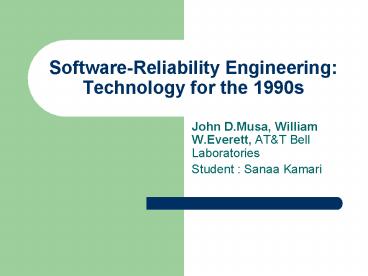SoftwareReliability Engineering: Technology for the 1990s PowerPoint PPT Presentation
1 / 7
Title: SoftwareReliability Engineering: Technology for the 1990s
1
Software-Reliability Engineering Technology for
the 1990s
- John D.Musa, William W.Everett, ATT Bell
Laboratories - Student Sanaa Kamari
2
What is it?
- Software reliability engineering is the applied
science of predicting, measuring, and managing
the reliability of software based systems to
maximize customer satisfaction.
3
Why is it important?
- Customers of software suppliers have become very
demanding in their requirements. - The costs of operational disruptions and recovery
that the customer encounters due to failures have
increased. - Increased demand for quality also increases the
importance of precisely measuring how well your
competitors are doing in providing quality to the
market. - There appears to be a strong correlation between
interest in adopting reliability-engineering
technology and the competitiveness of the
organization or project concerned.
4
Basic concepts
- Software failure some behavior of the execution
program that does not meet the customers
operational requirements. - Software fault a defect in the code that may
cause a failure. - Software-reliability proper is the probability of
failure free operation for a specified time
duration. - Failure intensity refers to the number of
failures experienced per time period. - Operational profile the set of functions the
software can perform with their probabilities of
occurrence.
5
Setting improvement goals
- Percentage improvement goal in terns of the
customer-oriented failure vs. the
developer-oriented fault density. - Quality-improvement effort on the functions used
more frequently. - Example a system performs only two functions
- A 90 of the time. with 50 faults.
- B 10 if the time with 50 faults.
- failure density 0.9(50)k 0.1(50)k 50k
- if you concentrate on the most used function B
so it has no fault. - New failure density 0.1(50)k
6
Life cycle
- Software-reliability engineering is applied in
every phase of the life cycle. - Definition phase should include the product's
failure-intensity objective. - Design and implementation phase should allocate
the system-reliability objectives among the
components. - Validation phase software-reliability
measurements (Reltools). - Operation and maintenance phase
reliability-measurements can help monitor the
operating softwares reliability. - Process improvement root-cause-analysis of
faults.
7
Research opportunities
- Predicting reliability before program execution
from characteristics of the software product and
the development process. - Estimating before test need to find a way to
estimate the number of remaining faults based on
patterns of data taken on design errors detected
on design inspections and coding faults detected
in desk-checking or code walk-throughs. - Estimating during test need to develop ways of
applying software-reliability theories to
estimating failure during unit test.

